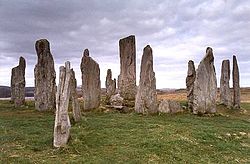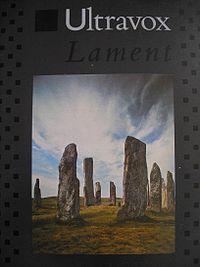- Callanish Stones
-
The Callanish Stones (or "Callanish I"), Clachan Chalanais or Tursachan Chalanais in Gaelic, are situated near the village of Callanish (Gaelic: Calanais) on the west coast of Lewis in the Outer Hebrides (Western Isles of Scotland).
Contents
Construction and description
Construction of the site took place between 2900 and 2600 BC, though there were possibly earlier buildings before 3000 BC. A tomb was later built into the site. Debris from the destruction of the tomb suggests the site was out of use between 2000 BC and 1700 BC.[1] The 13 primary stones form a circle about 13 m in diameter, with a long approach avenue of stones to the north, and shorter stone rows to the east, south, and west. The overall layout of the monument recalls a distorted Celtic cross. The individual stones vary from around 1 m to 5 m in height, with an average of 4 m, and are of the local Lewisian gneiss.
Interpretation
The first written reference to the stones was by Lewis native John Morisone, who in c. 1680 wrote that "great stones standing up in ranks [...] were sett up in place for devotione".
The tallest of the stones marks the entrance to a burial cairn where human remains have been discovered. An excavation campaign in 1980 and 1981 showed that the burial chamber was a late addition to the site, and that it had been modified a number of times. Pottery finds suggested a date of 2200 BC for the erection of the circle. It has been speculated, among other theories, that the stones form a calendar system based on the position of the moon. Professor Alexander Thom suggested that the alignment of the stone avenue (when looking southward) pointed to the setting of midsummer full moon behind a distant mountain called Clisham.
Critics of these theories argue that several alignments are likely to exist purely by chance in any such structure. In addition many factors such as the weathering and displacement of the stones over the millennia mean we can never be certain of any original, possibly intentional, alignments.
The stones in folklore and popular culture
Local tradition says that giants who lived on the island refused to be converted to Christianity by Saint Kieran and were turned into stone as a punishment. Another local belief says that at sunrise on midsummer morning, the "shining one" walked along the stone avenue, "his arrival heralded by the cuckoo's call." This legend could be a folk memory recalling the astronomical significance of the stones.
File:Callanish Sculpture 1 "Steelhenge".jpgGerald Laing's steel sculpture Callanish in the campus of Strathclyde UniversityIn 1974, the sculptor Gerald Laing created a work known as Callanish for Strathclyde University's campus in the centre of Glasgow. He created 16 abstract steel girders planted in the ground - intended to mimic the configuration of the real stones. The sculpture is popularly referred to as "Steelhenge".
The Callanish Stones in the early 1980s, as portrayed on the cover of Lament, by Ultravox
In 1984, the new romantic band Ultravox used an image of the stones on the cover of their album Lament. They also used the scenery to record the video of One Small Day, first single taken from that album. In 1988 Jon Mark released a CD, The Standing Stones of Callanish, intended to evoke Britain's celtic legacy.[2]
Other nearby sites
Archaeologists usually refer to the main monument as "Callanish I", because there are several other megalithic sites in the vicinity:
- "Cnoc Ceann a' Ghàraidh" (Callanish II) – stone circle
- "Cnoc Filibhir Bheag" (Callanish III) – stone circle
- "Ceann Hulavig" (Callanish IV) – stone circle
- "Àirigh nam Bidearan" (Callanish V) – stone alignment
- "Cùl a' Chleit" (Callanish VI) – stone circle
- "Cnoc Dubh" (Callanish VII) – ancient settlement or "shieling" (stone dwelling used while tending cattle on summer pastures)
- "Tursachan" (Callanish VIII) – unique semicircular monument at the edge of a sheer cliff on the nearby island of Great Bernera
- "Àird A' Chaolais" (Callanish VIIIa) - standing stone
- "Àirigh Nam Bidearan" (Callanish IX) - stones
- "Na Dromannan" ("Druim Nan Eun") (Callanish X)
- "Beinn Bheag" (Callanish XI) - standing stone; stones; cairns
- "Stonefield" (Callanish XII) - standing stone
- "Sgeir Nan Each" (Callanish XIII) - stone setting
- "Cnoc Sgeir Na h-Uidhe" (Callanish XIV W) - stone setting
- "Cnoc Sgeir Na h-Uidhe" (Callanish XIV e) - stones
- "Àirigh Mhaoldonuich" (Callanish XV) - standing stone
- "Cliacabhadh" (Callanish XVI) - standing stone; stones
- "Druim Na h-Aon Choich" (Callanish XVII) - standing stone (possible)
- "Loch Crogach" (Callanish XVIII) - standing stone (possible)
- "Buaile Chruaidh" (Callanish XIX) - standing stone (possible)
- There are many other sites nearby; not all are now visible. There was, for instance, a timber circle 0.5 km south at Loch Roag.
See also
- List of archaeoastronomical sites sorted by country
- List of megalithic sites
Notes
- ^ Armit 1998:61
- ^ Watson, Mike. "Essential releases: Jon Mark". AmbientMusicGuide. Mike Watson. http://www.ambientmusicguide.com/pages/M/mark.php. Retrieved 4 January 2010.
References
Armit, I. (1998). Scotland's Hidden History. Tempus. ISBN 07524-1400-3.
External links
- Map sources for Callanish Stones
- Breasclete Association local area's website
- Many photos of Calanais I; links to photos of other Calanais sites
- Megalithic Portal: photos, locations and descriptions of Callanish I – XIX and other nearby sites
- RCAHMS Canmore entry on Callanish
Coordinates: 58°11′49″N 6°44′42″W / 58.197°N 6.745°W
Prehistoric Western Isles Callanish Sites Other Neolithic Sites Bronze and Iron Age Sites European megaliths Armenia Azerbaijan Gobustan Rocks ·France Barnenez · Tumulus of Bougon · Carnac stones · Menhir de Champ-Dolent · Broken Menhir of Er Grah · Filitosa · Harrespil · Kerzerho · Paddaghju · TremecaGermany Megaliths in Mecklenburg-Vorpommern · Lancken-Granitz dolmensIreland Jersey Malta Ġgantija · Hagar Qim · Ħal-Saflieni · Megalithic Temples of Malta · Mnajdra · Ta' Ħaġrat · Skorba · TarxienPoland Portugal Russia Scandinavia Ukraine Boundary stonesUnited Kingdom EnglandAvebury · Birkrigg · Boscawen-Un · Boskednan Stone Circle · Brown Willy Cairns · Devil's Arrows · Castlerigg Stone Circle · Craddock Moor stone circle · Doll Tor · Drizzlecombe · Duloe stone circle · Fernacre · Goodaver stone circle · Grey Wethers · Hoarstones · Hurlers · Leper Stone · Long Meg · The Merry Maidens · Mitchell's Fold · Nine Ladies · Nine Stones · Pipers · Rollright Stones · Rudston Monolith · Scorhill · Stannon stone circle · Stanton Drew · Stonehenge · Stripple stones · Swinside · Trippet stonesNorthern IrelandScotlandBalquhain · Carlin stone · Pictish stones · Stones of Scotland
Callanish - Callanish I, Callanish II, Callanish III, Callanish IV, Callanish VIII and Callanish X
Clach an Truiseil · Colmeallie stone circle · Drybridge · Easter Aquhorthies · Ring of Brodgar · Sheldon Stone Circle · Standing Stones of Stenness · Steinacleit · Strichen Stone CircleWalesBryn Cader Faner · Coetan Arthur · Carreg Coetan Arthur · Moel Tŷ Uchaf · Pentre Ifan · Parc Cwm long cairn · St Lythans · Tinkinswood · WhetstonesGeneral articles Standing stone · Dolmen · Henge · Menhir · Stone circle · Stone row · Concentric stone circle · Recumbent stone circle · Chambered cairn · Harrespil · Photographs of stone circlesSettlements and Places of Interest in the Outer Hebrides (Na h-Eileanan Siar) on Lewis
and HarrisStornoway · Aird · Back · Balallan · Barvas · Bayble · Bragar · Breaclete (Great Bernera) · Brenish · Carloway · Garrabost · Ness · Portnaguran · Portvoller · Shawbost · Skigersta · Shulishader · Tong · Valtos/Uig
Tarbert · Leverburgh · Luskentyre · Northton · Rodel
on North Uist,
Benbecula
and South UistLochmaddy · Sollas
Lochboisdale · Balla (Eriskay) · Daliburgh · Geirinis · Howmore · Stoneybridge
Balivanich · Linaclateon Barra Places of Interest Amhuinnsuidhe Castle · An Lanntair · Arnol Blackhouse · Barra Airport · Callanish Stones · Dun Carloway · Garenin · Golden Road · Kisimul Castle · Lewis Loom Centre · Lews Castle · St. Clement's Church · St Moluag's ChurchCategories:- Megalithic monuments in Europe
- 22nd-century BC architecture
- Archaeoastronomy
- Archaeological sites in the Western Isles
- History of the Western Isles
- Lewis
- Stone circles in Scotland
- Scheduled Ancient Monuments in Scotland
- Stone Age sites in Scotland
- Historic Scotland properties
- Neolithic Scotland
Wikimedia Foundation. 2010.



